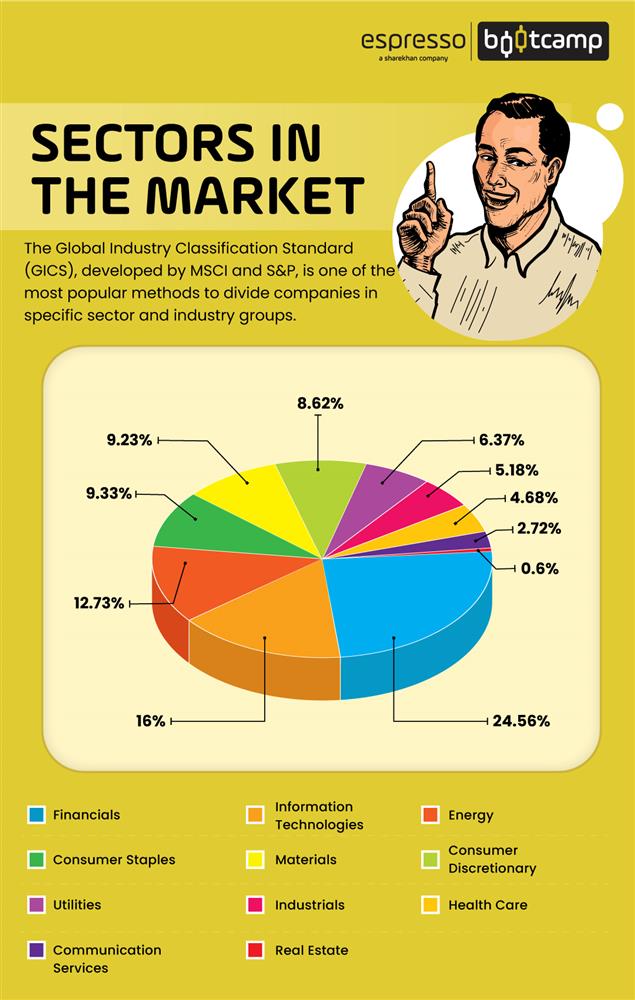If you look up the Oxford Learner’s Dictionary, you will find 'sector' defined as sector (noun): a part of an area of activity, especially of a country's economy. While the word is used in different contexts by economists, urban planners and investors, in the capital market parlance, sector refers to an industry such as automobile, banking and pharmaceuticals.
If you look at various stock market sectors, stocks are grouped basis of the products/services offered by the company. The reason being the stocks within a stock market sector will have similar concerns, benefits and impacts from external factors and events. An increase in metal prices will affect all automobile manufacturers and, consequently, all auto stocks. Similarly, scarcity of coal will affect power producers and their performance in the stock markets.
Here are the top 10 sectors in India (NSE) by market capitalisation (as of 17/03/2022)
| Sector | Market Cap (in crore rupees) |
|
Software & IT Services |
3,678,139 |
|
Banks |
2,970,567 |
|
Oil & Gas |
2,195,112 |
|
Finance |
2,074,690 |
|
FMCG |
1,698,241 |
|
Automobile & Ancillaries |
1,417,320 |
|
Healthcare |
1,416,075 |
|
Chemicals |
1,275,896 |
|
Metals & Mining |
1,207,851 |
|
Power |
861,745 |
Pro Tip: If you want to become a fundamental analyst, knowledge of various sectors is a prerequisite.

Sources of Information
The first step in sector analysis is knowing your sources of information to gather relevant data. Here’s a list of the key ones:
Industry associations:
All sectors in the share market have their own associations that make representation to government agencies on various issues concerning the industry. For the government, too, it’s easier to deal with a single body than to engage with individual manufacturers from various stock market sectors.
Stock market sectors list with names of their associations in Indian stock markets:
| Sector | Association |
|
Cement |
Cement Manufacturers Association |
|
Automobiles |
Society of Indian Automobile Manufacturers |
|
Sugar |
Indian Sugar Mills Association |
|
Tyre |
Automotive Tyre Association |
|
Software & IT Services |
National Association of Software and Service Companies (NASSCOM) |
|
Chemicals |
Indian Chemical Council |
|
Real Estate |
National Real Estate Development Council (NAREDCO) |
Apart from making representations on members’ behalf, associations of these different stock market sectors also have data about the production, installed capacity, etc., about their industry and highlight the burning issues affecting the sector. They often prepare detailed reports related to their industry, which are comprehensive resources and provide plenty of information.
Newspapers:
Newspapers, especially business publications, are regular sources of information on stock market sectors. The internet is a great place to access portals that provide exclusive information about stock market sectors from different industries. In fact, they provide news before the newspapers can. If you want to be a sector expert, go through websites and newspapers to keep a track of the activities in the sectors of your interest.
Annual Reports:
Management discussions and analyses, which are part of directors’ reports in company annual reports, often contain information on how an industry as a whole performed during a year. Companies from various stock market sectors have to compulsorily provide shareholders with their annual reports.

This is an excerpt from the management discussion and analysis of a leading cement manufacturing company. It explains how the industry has performed during the year under review and what factors affected the industry. This is valuable, first-hand authentic information about the company, which is difficult to find elsewhere. Annual reports can be accessed on a company’s official website.
Analyst conference calls: They are usually arranged after the quarterly results and provide insights into what’s happening in the industry. Transcriptions of these con-calls are usually found on company websites as well as at the stock exchanges. You will get important information about sector margins, demand-supply scenario and new projects in the sector.

This is a brief extract of a con-call transcription of a leading wood panel manufacturer, which gives a glimpse of the future prospects of the industry.
Economic Survey and Annual Budget:
The Union government releases Economic Surveys every year just before the Annual Budget. It throws light on the performance of various stock market sectors and gives enough clues about their prospects.
Similarly, the Annual Budget is important as the future of the economy and different sectors in share market depend upon various provisions. The Budget contains information about the government's capital allocations to various sectors and tax provisions affecting the same.
Company Prospectus:
Whenever a company wants to raise funds from the capital market (either through IPO or FPO), it has to take approval from the market regulator, SEBI. For that purpose, the company needs to file a prospectus, which contains, among other things, information about the stock sectors in which the applicant is operating.

Above is the portion of information about India’s healthcare sector given in a prospectus filed with SEBI by an IPO aspirant. These documents are publicly available and are easily accessible on SEBI’s website.
Sector analysis: Points to remember
Now that you know what the sectors in the economy are and the sources to garner information on them, how do you analyse the information? Of course, your analytical skills will develop with time and experience, and as an analyst, you have to keep track of several factors in each of the stock market sectors on a regular basis. These include:
Demand-supply equilibrium:
The most important aspect of the analysis is ascertaining the demand-supply situation in the stock market sector you are tracking. A wide gap between the two sectors will upset the equilibrium and hence impact prices. Different sectors in stock market face different challenges. Capacity additions, plant shutdowns (for maintenance or otherwise), labour strikes in the factory, etc., are some of the factors, either locally or globally, which have the potential to disrupt the existing demand-supply equilibrium in various stock sectors.
Potential demand:
Changes in the fortunes of the user industry will have an impact on the demand scenario impacting different sectors in stock market. For e.g., the recovery in demand for real estate in 2021-22 has had a positive impact on the building materials industry.
Raw materials scenario:
Likely disruption in the supply of raw materials due to strikes, wars, natural calamities and plant shutdowns in any part of the world will have an impact on the supply and, consequently, its price all over the world. Look at the price movement of metals and oil & gas after the war between Russia and Ukraine in February 2022. Go back to the Gulf War of the 90s to spot similar trends.
Government decisions:
Budgetary provisions such as increases or decreases in duty rates will have an immediate impact on the fortunes of industries. Analysts should also cover both raw material sourcing and end-user industries. Announcements of new schemes/programmes may increase the demand for the stock sector’s products.
For e.g., the government’s decision to promote the use of LED bulbs increased the demand for LED bulbs in the country. In addition, the Swachh Bharat Mission, which promoted the construction of toilets, increased the demand for sanitaryware and tiles. Increased allocation for the housing and infrastructure sector is likely to push demand for cement and other building materials in the country.
Global developments:
Geopolitical tensions (like the war between Russia and Ukraine), natural calamities, any foreign government’s decision to allow/ban import/export of certain commodities, drought/floods/diseases affecting crops like sugar, coffee and tea are some of the factors you, as analysts, should always be aware of.
Points to remember
- Identifying stocks through sector analysis is a natural sequence of (top-down approach) fundamental analysis and definitely the easier way
- There are fewer stock market sectors, so they are easier to track and analyse than thousands of individual stocks
 0
|
0
|
 0
0
 Modules
Modules

 Watch
Watch 
